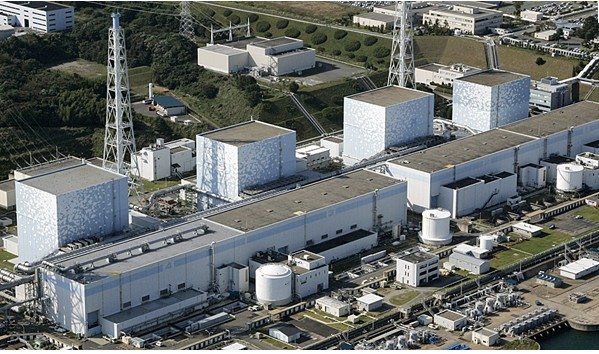Japan’s nuclear crisis escalated Tuesday as two more blasts and a fire rocked a quake-stricken atomic power plant, sending radiation up to dangerous levels.
Radiation around the Fukushima No.1 plant on the eastern coast had “risen considerably”, Prime Minister Naoto Kan said, and his chief spokesman announced the level was now high enough to endanger human health.
In Tokyo, some 250 kilometres (155 miles) to the southwest, authorities also said that higher than normal radiation levels had been detected in the capital, the world’s biggest urban area, but not at harmful levels.
Kan warned people living up to 10 kilometres (six miles) beyond a 20 km (12-mile) exclusion zone around the nuclear plant to stay indoors.
The fire, which was later extinguished, broke out in the plant’s number-four reactor, he said, meaning that four out of six reactors at the facility were now in trouble.
As well as the atomic emergency, Japan is struggling to cope with the enormity of the damage from Friday’s record quake and the tsunami that raced across vast tracts of its northeast, destroying all before it.
The official death toll rose to 2,414, police said Tuesday, while officials said at least 10,000 were likely to have perished.
But in the only country in the world to have experienced a nuclear attack — two bombs dropped by the United States during World War II killed some 200,000 people — Japanese citizens are gripped by fear of nuclear fallout.
“What we most fear is a radiation leak from the nuclear plant,” Kaoru Hashimoto, 36, a housewife living in Fukushima city 80 kilometres (50 miles) northwest of the stricken plant, told AFP by phone.
“Not much confirmed information is coming to us, so we are in trouble about how to cope with the situation.”
Hashimoto said supermarkets were open but shelves were completely empty. “Many children are sick in this cold weather but pharmacies are closed. Emergency relief goods have not reached evacuation centres in the city.
“I’m wondering how long we can manage with the food we have in stock. Everyone is anxious and wants to get out of town. But there is no more petrol. We are afraid of using a car as we may run out of petrol.”
More than 200,000 people have already been evacuated from the exclusion zone around the crippled plant.
At one shelter, a young woman holding her baby told public broadcaster NHK: “I didn’t want this baby to be exposed to radiation. I wanted to avoid that, no matter what.”
The crisis at the ageing Fukushima plant has worsened daily since Friday’s quake and tsunami knocked out cooling systems.
On Saturday an explosion blew apart the building surrounding the plant’s number-one reactor. On Monday, a blast hit the number-three reactor, injuring 11 people and sending plumes of smoke billowing into the sky.
Early on Tuesday a blast rocked the number-two reactor. That was followed by a hydrogen explosion that started a fire at the number-four reactor.
Chief government spokesman Yukio Edano said radioactive particulates leaked along with the hydrogen.
The UN’s nuclear watchdog, the International Atomic Energy Agency, said Tokyo had asked for expert assistance in the aftermath of the quake, which US seismologists are now measuring at 9.0-magnitude, revised up from 8.9.
But the IAEA’s Japanese chief Yukiya Amano moved to calm global fears that the situation could escalate to rival the world’s worst nuclear accident at Chernobyl in Ukraine in 1986.
“Let me say that the possibility that the development of this accident into one like Chernobyl is very unlikely,” he said.
In Tokyo, the French embassy on Tuesday retracted an earlier statement indicating that a radioactive cloud was headed for the capital, saying the city was not at risk.
“Preliminary information gathered early in the morning was not confirmed and was immediately removed from the embassy’s website,” a spokesman told AFP.
“The weather forecast indicates that the wind is changing direction — Tokyo is not threatened by radioactive fallout,” an embassy statement said.
Further north in the region of Miyagi, which took the full brunt of Friday’s terrifying wall of water, rescue teams searching through the shattered debris of towns and villages have found 2,000 bodies.
And the Miyagi police chief has said he is certain more than 10,000 people perished in his prefecture.
Millions have been left without water, electricity, fuel or enough food and hundreds of thousands more are homeless and facing harsh conditions with sub-zero temperatures overnight, and snow and rain forecast.
Aid workers and search teams from across the world have joined 100,000 Japanese soldiers in a massive relief push in the shattered areas, where the tsunami swallowed entire towns.
Tokyo stocks, which were punished Monday when the markets reopened, sending indexes around the world sliding, plummeted another 14 percent on Tuesday before paring some losses and ending 10.55 percent down.
Panic selling saw stocks close more than six percent lower in Tokyo Monday on fears for the world’s third-biggest economy, as power shortages threatened rolling blackouts and prompted factory shutdowns in quake-hit areas.
The government expects a “considerable” economic impact from the disaster, which has plunged the nation into what Prime Minister Kan called its worst crisis since World War II.










